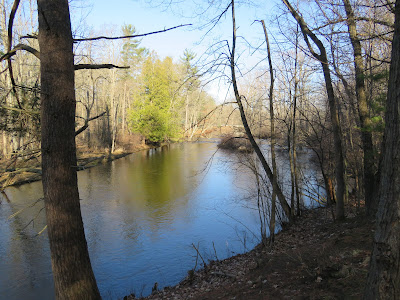I begin my morning nature hike alone in St Louis Michigan at the Emma Burnham Outdoor Center with temperatures in the low 50’s, mostly cloudy skies and a stiff west wind. Shortly after entering a dense, leafless forest of oak, maple and beech, I hear the distant call of a female Wood Duck as she takes off from one of the many vernal ponds. Soon thereafter, from a bare canopy, I hear the loud call of a Pileated Woodpecker and from the ground below, I see a tree stump that it had shredded earlier in searched for food. After walking over a thick layer of leaf litter, I come upon an oak tree with a large, 3-ft burl on its trunk. A burl is a collection of tree cells called callus tissue. Normally, this tissue is formed by a tree in response to a disease, insect or storm damage. As a burl grows, it incorporates the tree’s undeveloped buds that surround it and folds them into its expanding form. Although burls grow into weird shapes and sizes on trees that otherwise look normal, a burl itself is not diseased or contagious. Over the years, burl wood has become quite valuable for making unique furniture (stock photo). Up ahead, other subtle signs of the season include a few Trout Lily leaves on the ground and a Honeysuckle shrub beginning to leaf out. Nearby, I spot a patch of Wild Leeks. Also called ramps, these plants are one of the earliest wild edibles to emerge, and, for some, they're the holy grail of wild edibles. They're really a type of wild onion with a unique garlicky-onion flavor. Historically ramps were considered a spring tonic in the Appalachians. Early settlers looked forward to harvesting them after long, hungry winters, as it would have been one of the first vegetables they had eaten in months. Fungi that catch my attention include Oyster and Turkey Tail mushrooms. Looping back toward the car, I explore a small pond while noticing a perching male Redwing Blackbird establishing his nesting territory and the fuzzy nubs of a Pussy Willow. These soft silver tufts—as well as the plant itself—are named for their resemblance to tiny cats’ paws. These tufts actually are flower buds just before they bloom. The soft coating of hairs acts as insulation to protect these early bloomers from cold temperatures. On the eve of Earth Day, it seems fitting to observe through the trees a rotating wind turbine- a source of clean energy for our planet that reduces dependence on fossil fuels and resulting air pollution from their combustion.
Planet earth, child of the sun
You’re a very special one
Water to drink, air to breathe
Life abounds on land and sea
Some worlds, far too cold
Living things can’t take hold
Some worlds, way too hot
Does life exist? Probably not
Sphere of blue, sphere of white
Your place in space, just right
Mother Earth, this much is true
Human survival depends on you
D. DeGraaf



